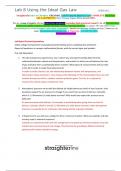Lab 8 Using the Ideal Gas Law CHEM101L
Straighterline Intro to Chemistry CHEM101L Lab 8 Using the Ideal Gas Law COMPLETE Worksheet
with LAB PHOTOS (New Version August 2024) Scored 100%
We are a team of experts offering course/class attendance (including final proctored exams!!) for all Straighterline,
Online ATI, HESI, NCLEX, Portage Learning, Sophia, Nursing, Business etc courses. We also write essays,
discussion posts, research papers and school assignments. Should you need any of these services, Contact us via
email: merchantmuchiri@gmail.com or WhatsApp: +1 (540) 753-5914.
Guaranteed Passing!
Lab Report Format Expectations
Utilize college level grammar and professional formatting when completing this worksheet.
Report all equations in a proper mathematical format, with the correct signs and symbols.
Pre-Lab Questions
1. This lab includes two experiments, one in which you will experimentally determine the
relationship between volume and temperature, and another in which you will observe the rate
of gas evolution from a catalytically driven reaction. What types of measurements will you take
in this lab in order to study these phenomena?
In order to verify Charles' Law, the relationship between volume and temperature, and
observations of gas evolution, I must measure the following: In the second experiment, you will
monitor the pace at which a catalytic reaction produces gases. For this, it is required to
measure the volume of gas created over time.
2. Atmospheric pressure varies with the altitude (or height above sea level) of your location. How
would you expect the air pressure to change if you went from sea level to Denver, Colorado,
which is 1.5 kilometers (1 mile) above sea level? Why would you expect the pressure to be
different?
Air pressure drops with altitude. For example, it would drop when going from sea level to
Denver, Colorado, which is around 1.5 kilometers (1 mile) above sea level. Lower atmospheric
pressure is caused by the air molecules' decreasing density at greater altitudes.
3. In Experiment 2, you will use a catalyst to drive a chemical reaction. What are catalysts and why
are they used in chemical reactions?
Catalysts are substances that lower the energy barrier to speed up chemical reactions; once the
reaction has occurred, they do not change. They function by providing a different chemical
pathway with a lower activation energy.
, Lab 8 Using the Ideal Gas Law CHEM101L
EXPERIMENT 1: CHARLES’ LAW
Introduction Questions
1. What is the overall purpose of Experiment 1? What results do you expect and why?
The primary objective of Experiment 1 is to investigate the relationship between a gas's volume
and temperature, mainly using Charles' Law. Charles' Law states that, at constant pressure, a
gas's volume is inversely proportional to its Kelvin temperature. The purpose of Experiment 1 is
to determine whether the volume of the gas increases with temperature. This is because when
the temperature rises, the gas molecules gain more kinetic energy. This allows them to move
more quickly and occupy more space, increasing the gas's volume. We can determine the
relationship between the two variables by using a line of best fit to graph the temperature and
volume data. The line must have a positive slope proportionate to the two variables. The
expected results align with ideal gas behavior, which states that a gas's volume is inversely
proportionate to its temperature, and Charles' Law.
2. What does Charles’ Law state regarding the relationship between pressure, volume and
temperature. Explain each of these three variables as they pertain to this law.
According to Charles' Law, a gas's volume and temperature are directly related when there is
constant pressure. According to this law, temperature is the average kinetic energy of the gas
molecules, volume denotes the space occupied by the gas, and pressure is the force that the gas
molecules exert per unit area. The volume of the gas grows in proportion to rising temperature
and contracts in response to falling temperature.
3. In this experiment, you will assume that you can draw a straight line through the Temperature
and Volume data you observe. Why can you do this?
The assumption that one can draw a straight line across the volume and temperature data is
supported by Charles's Law. Charles' Law states that the volume of a given amount of gas is
directly proportional to its temperature on the absolute temperature scale (Kelvin) if both
pressure and the amount of gas stay constant. This relationship can be represented as V1/T1 =
V2/T2, where V1 and T1 are the initial volume and temperature and V2 and T2 are the final
volume and temperature. Charles' Law states that you should get a straight line when plotting
volume against temperature. This is because volume and temperature always have a
relationship.




